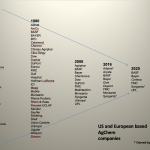Banana growers have recently been invited to take part in reviews into the future use of agrichemicals. Consultant Kevin Brodnaruk answers a series of questions to help explain the current climate in the agrichemical industry. Kevin has more than 30 years’ experience in the areas of pesticide development, use and regulation. He is currently working with agricultural industries, government agencies and research and development corporations and in the area of pesticide regulation and risk assessment
1. What are the biggest changes and challenges in the agrichemical industry for horticulture?
Aside from managing resistance and incursions of exotic pests and diseases, I think a big challenge for horticulture will be ensuring there are enough tools for growers to manage their pest, disease and weed problems.
Firstly, there has been a continuing trend in company mergers and acquisitions reducing the number participating in the farm chemical market. As a result, there is likely to be fewer companies involved in research, plus rationalising of existing product portfolios, which in the mid-term, could result in fewer new chemistries/technologies being developed and brought to market.
Secondly, in global terms Australia is a relatively small farm chemicals market, with herbicides making up more than half. For horticultural industries,
gaining access to new technologies could become more difficult as the cost of developing uses for many of the smaller Australian horticultural industries may not be seen as commercially justifiable.
Thirdly, for export-oriented industries, the challenge will be how best to ensure compliance with importing countries standards. At the moment, Maximum Residue Limit (MRL) setting is not globally harmonised. MRLs can differ between countries, which can make compliance difficult. This means growers may have to exclude a farm chemical to ensure their exported produce complies with an importing country’s standards.
Lastly, regulatory pressures on farm chemicals are increasing internationally and in Australia. Older chemistries are being re-evaluated to ensure they comply with current health and environmental standards with regulators applying newer risk assessment methodologies.
The scope of pest management options available to growers is finite, so any factor that potentially reduces options can have an impact.
2. What are the issues that industry needs to be concerned about in relation to chemical/pesticide use in the banana industry moving forward?
I think probably the main issue moving forward will be access to new technologies that best fit with industry practices and constraints. The relatively small size of the Australian farm chemical market can often result in new technologies, when brought to Australia, being initially developed in major crops, delaying access for minor crops. This can often result in a lag of a number of years before a registrant seeks to expand label uses, assuming it has a fit.
A positive of the Australian regulatory system is the ability to gain permitted uses. Where the Australian Pesticides and Veterinary Medicines Authority (APVMA) is satisfied a proposed use complies with regulatory standards, off- label uses can be approved allowing growers to access new pest management options. This provides a potential pathway to gaining access earlier to a new technology or to an existing option where a gap has been identified.
3. Recently, growers have been invited to provide feedback to reviews on current pesticide/chemical use in horticulture industries? What is driving this?
Australia applies a risk-based approach when assessing farm chemicals. The risk assessment methodologies, now employed by the regulatory authorities
have progressed, so the purpose of the reviews is to ensure approved uses meet those contemporary health and environmental standards. As most of the chemicals under review were last assessed some time ago, it has been seen as prudent that they be re-evaluated. To try and ensure their risk assessments are based on current practices the APVMA seeks input on specific work practices.
4. Some chemicals could be lost to the banana industry? What are the implications for growers?
I would expect that the implications could be significant, should the outcome
of a chemical review be the cancellation of a use, particularly if it involves something that is widely used. Where cancellation is recommended, industry would need to consider whether an alternative is needed, engage with registrants and the APVMA, particularly if access via an APVMA permit is the best pathway in the first instance.
5. What should industry and growers be doing moving forward to ensure access is maintained to agrichemicals?
I believe the thinking around pest management going forward needs to be strategic. To be effective this will need stakeholders to be well informed. To achieve this, it is going to require industry engagement with the registrants and the regulator regarding specific chemicals, and the government where policy initiatives are being considered.
6. What are the challenges of maintaining or retaining access to chemicals/pesticides?
The challenge for industries will be to recognise that this is a possibility for many older farm chemicals and the need to be strategic when considering currently available pest management options. Satisfying regulatory requirements for an old farm chemical could be prohibitively expensive with no guarantee of a positive outcome, whereas pursuing a newer technology may be a more effective approach from a long-term perspective.
A graph showing the chemicals and pesticides withdrawn from the market by American and European-based agri-chemical companies over the past 60 years.

